Submitted:
08 March 2024
Posted:
11 March 2024
You are already at the latest version
Abstract
Keywords:
1. Introduction
- “Deep and meaningful formal learning is supported, as long as one of the three forms of interaction (student-teacher; student-student; student-content) is at a high level. The other two may be offered at minimal levels, or even eliminated, without degrading the educational experience.
- High levels of more than one of the above three modes will likely provide a more satisfying educational experience, although these experiences may not be as cost- or time-effective as less interactive learning sequences.”
2. Related Work
3. Methodology
3.1. Participants
3.2. Dataset
- The actions with the indication “discussion created” and “post created”, are separately assorted from the log file.
- The "discussion created" actions provide information on the creation of new discussion threads. Each thread is assigned to the participant who created it (student or tutor).
- Each post is assigned to the participant who uploaded it and to the corresponding discussion thread that belongs to.
- Each participant is represented as a node.
- An incoming edge to a node represents a reply to a discussion thread, this participant has created (i.e., if Ast5 has three incoming edges then that means that three participants had posted in the threads that Ast5 has created).
- An outgoing edge of a node denotes the posts that this specific participant made to other participants' threads (i.e., if Bst2 has 8 outgoing edges, then that means that Bst2 had replied in the threads that 8 other participants had created).
- A self-loop denotes that the participant who made a post and created a thread replied to his/her original post.
3.3. Metrics and algorithms
4. Results and Discussion
5. Conclusions
- Feelings of personal relation between the teaching and learning parties promote study pleasure and motivation. Such feelings can be fostered by well-developed self-instructional material and two-way communication at a distance,
- Intellectual pleasure and study motivation are favorable to the attainment of study goals and the use of proper study processes and methods,
- The atmosphere, language and conventions of friendly conversation favor feelings of personal relation according to postulate 1,
- Messages given and received in conversational forms are comparatively easily understood and remembered.
Appendix Correlation Table
| Course A- | |||
| Variable A | Variable B | Correlation value | p value |
| WA1 | WA2 | 0,385 | 0,156 |
| WA1 | WA3 | -0,011 | 0,968 |
| WA1 | WA4 | -0,130 | 0,644 |
| WA1 | In-degree | 0,263 | 0,344 |
| WA1 | Out-degree | -0,149 | 0,595 |
| WA1 | Degree | 0,235 | 0,400 |
| WA1 | Weighted In-degree | 0,230 | 0,410 |
| WA1 | Weighted Out-degree | -0,040 | 0,887 |
| WA1 | Weighted Degree | 0,179 | 0,523 |
| WA1 | Eccentricity | -0,730 | 0,002* |
| WA1 | Closeness centrality | -0,045 | 0,873 |
| WA1 | Harmonic closeness centrality | -0,082 | 0,773 |
| WA1 | Betweenness centrality | 0,071 | 0,800 |
| WA1 | Authority | 0,218 | 0,436 |
| WA1 | Hub | 0,106 | 0,706 |
| WA1 | PageRank | 0,240 | 0,389 |
| WA1 | Eigenvector centrality | 0,179 | 0,523 |
| WA1 | Av. WA | 0,125 | 0,658 |
| WA2 | WA3 | 0,245 | 0,379 |
| WA2 | WA4 | -0,076 | 0,788 |
| WA2 | In-degree | 0,309 | 0,263 |
| WA2 | Out-degree | -0,644 | 0,010* |
| WA2 | Degree | 0,013 | 0,964 |
| WA2 | Weighted In-degree | 0,231 | 0,406 |
| WA2 | Weighted Out-degree | -0,434 | 0,106 |
| WA2 | Weighted Degree | 0,034 | 0,903 |
| WA2 | Eccentricity | -0,335 | 0,222 |
| WA2 | Closeness centrality | -0,393 | 0,148 |
| WA2 | Harmonic closeness centrality | -0,391 | 0,149 |
| WA2 | Betweenness centrality | 0,110 | 0,696 |
| WA2 | Authority | 0,275 | 0,321 |
| WA2 | Hub | -0,788 | 0,000* |
| WA2 | PageRank | 0,292 | 0,292 |
| WA2 | Eigenvector centrality | 0,202 | 0,470 |
| WA2 | Av. WA | 0,249 | 0,370 |
| WA3 | WA4 | 0,643 | 0,010* |
| WA3 | In-degree | 0,108 | 0,703 |
| WA3 | Out-degree | -0,380 | 0,162 |
| WA3 | Degree | -0,083 | 0,770 |
| WA3 | Weighted In-degree | -0,090 | 0,750 |
| WA3 | Weighted Out-degree | -0,583 | 0,023* |
| WA3 | Weighted Degree | -0,292 | 0,292 |
| WA3 | Eccentricity | -0,005 | 0,986 |
| WA3 | Closeness centrality | -0,222 | 0,427 |
| WA3 | Harmonic closeness centrality | -0,210 | 0,452 |
| WA3 | Betweenness centrality | 0,182 | 0,517 |
| WA3 | Authority | 0,200 | 0,476 |
| WA3 | Hub | -0,170 | 0,544 |
| WA3 | PageRank | 0,081 | 0,775 |
| WA3 | Eigenvector centrality | -0,043 | 0,880 |
| WA3 | Av. WA | 0,783 | 0,001* |
| WA4 | In-degree | -0,206 | 0,460 |
| WA4 | Out-degree | 0,106 | 0,708 |
| WA4 | Degree | -0,191 | 0,495 |
| WA4 | Weighted In-degree | -0,348 | 0,203 |
| WA4 | Weighted Out-degree | -0,296 | 0,284 |
| WA4 | Weighted Degree | -0,403 | 0,136 |
| WA4 | Eccentricity | 0,332 | 0,226 |
| WA4 | Closeness centrality | 0,315 | 0,253 |
| WA4 | Harmonic closeness centrality | 0,327 | 0,234 |
| WA4 | Betweenness centrality | 0,130 | 0,644 |
| WA4 | Authority | -0,045 | 0,874 |
| WA4 | Hub | 0,159 | 0,572 |
| WA4 | PageRank | -0,291 | 0,293 |
| WA4 | Eigenvector centrality | -0,389 | 0,152 |
| WA4 | Av. WA | 0,927 | 0,000* |
| In-degree | Out-degree | -0,578 | 0,024* |
| In-degree | Degree | 0,889 | 0,000* |
| In-degree | Weighted In-degree | 0,900 | 0,000* |
| In-degree | Weighted Out-degree | -0,144 | 0,608 |
| In-degree | Weighted Degree | 0,706 | 0,003* |
| In-degree | Eccentricity | -0,652 | 0,008* |
| In-degree | Closeness centrality | -0,766 | 0,001* |
| In-degree | Harmonic closeness centrality | -0,782 | 0,001* |
| In-degree | Betweenness centrality | -0,055 | 0,845 |
| In-degree | Authority | 0,807 | 0,000* |
| In-degree | Hub | -0,390 | 0,150 |
| In-degree | PageRank | 0,946 | 0,000* |
| In-degree | Eigenvector centrality | 0,576 | 0,025* |
| In-degree | Av. WA | -0,047 | 0,868 |
| Out-degree | Degree | -0,140 | 0,618 |
| Out-degree | Weighted In-degree | -0,296 | 0,284 |
| Out-degree | Weighted Out-degree | 0,801 | 0,000* |
| Out-degree | Weighted Degree | 0,047 | 0,868 |
| Out-degree | Eccentricity | 0,520 | 0,047* |
| Out-degree | Closeness centrality | 0,757 | 0,001* |
| Out-degree | Harmonic closeness centrality | 0,764 | 0,001* |
| Out-degree | Betweenness centrality | 0,149 | 0,595 |
| Out-degree | Authority | -0,546 | 0,035* |
| Out-degree | Hub | 0,653 | 0,008* |
| Out-degree | PageRank | -0,575 | 0,025* |
| Out-degree | Eigenvector centrality | -0,104 | 0,713 |
| Out-degree | Av. WA | -0,142 | 0,614 |
| Degree | Weighted In-degree | 0,926 | 0,000* |
| Degree | Weighted Out-degree | 0,274 | 0,322 |
| Degree | Weighted Degree | 0,883 | 0,000* |
| Degree | Eccentricity | -0,500 | 0,058 |
| Degree | Closeness centrality | -0,504 | 0,055 |
| Degree | Harmonic closeness centrality | -0,520 | 0,047* |
| Degree | Betweenness centrality | 0,017 | 0,953 |
| Degree | Authority | 0,673 | 0,006* |
| Degree | Hub | -0,107 | 0,704 |
| Degree | PageRank | 0,826 | 0,000* |
| Degree | Eigenvector centrality | 0,640 | 0,010* |
| Degree | Av. WA | -0,137 | 0,627 |
| Weighted In-degree | Weighted Out-degree | 0,242 | 0,385 |
| Weighted In-degree | Weighted Degree | 0,933 | 0,000* |
| Weighted In-degree | Eccentricity | -0,592 | 0,020* |
| Weighted In-degree | Closeness centrality | -0,688 | 0,005* |
| Weighted In-degree | Harmonic closeness centrality | -0,703 | 0,003* |
| Weighted In-degree | Betweenness centrality | -0,097 | 0,730 |
| Weighted In-degree | Authority | 0,631 | 0,012* |
| Weighted In-degree | Hub | -0,342 | 0,213 |
| Weighted In-degree | PageRank | 0,837 | 0,000* |
| Weighted In-degree | Eigenvector centrality | 0,803 | 0,000* |
| Weighted In-degree | Av. WA | -0,226 | 0,419 |
| Weighted Out-degree | Weighted Degree | 0,574 | 0,025* |
| Weighted Out-degree | Eccentricity | 0,180 | 0,522 |
| Weighted Out-degree | Closeness centrality | 0,317 | 0,249 |
| Weighted Out-degree | Harmonic closeness centrality | 0,317 | 0,250 |
| Weighted Out-degree | Betweenness centrality | 0,040 | 0,887 |
| Weighted Out-degree | Authority | -0,293 | 0,289 |
| Weighted Out-degree | Hub | 0,350 | 0,200 |
| Weighted Out-degree | PageRank | -0,192 | 0,493 |
| Weighted Out-degree | Eigenvector centrality | 0,315 | 0,252 |
| Weighted Out-degree | Av. WA | -0,457 | 0,086 |
| Weighted Degree | Eccentricity | -0,433 | 0,107 |
| Weighted Degree | Closeness centrality | -0,463 | 0,083 |
| Weighted Degree | Harmonic closeness centrality | -0,476 | 0,073 |
| Weighted Degree | Betweenness centrality | -0,067 | 0,812 |
| Weighted Degree | Authority | 0,423 | 0,116 |
| Weighted Degree | Hub | -0,159 | 0,573 |
| Weighted Degree | PageRank | 0,635 | 0,011* |
| Weighted Degree | Eigenvector centrality | 0,795 | 0,000* |
| Weighted Degree | Av. WA | -0,360 | 0,188 |
| Eccentricity | Closeness centrality | 0,527 | 0,044* |
| Eccentricity | Harmonic closeness centrality | 0,575 | 0,025* |
| Eccentricity | Betweenness centrality | 0,264 | 0,342 |
| Eccentricity | Authority | -0,467 | 0,079 |
| Eccentricity | Hub | 0,046 | 0,870 |
| Eccentricity | PageRank | -0,626 | 0,013* |
| Eccentricity | Eigenvector centrality | -0,454 | 0,089 |
| Eccentricity | Av. WA | 0,094 | 0,740 |
| Closeness centrality | Harmonic closeness centrality | 0,998 | 0,000* |
| Closeness centrality | Betweenness centrality | 0,154 | 0,584 |
| Closeness centrality | Authority | -0,574 | 0,025* |
| Closeness centrality | Hub | 0,654 | 0,008* |
| Closeness centrality | PageRank | -0,724 | 0,002* |
| Closeness centrality | Eigenvector centrality | -0,530 | 0,042* |
| Closeness centrality | Av. WA | 0,132 | 0,639 |
| Harmonic closeness centrality | Betweenness centrality | 0,176 | 0,531 |
| Harmonic closeness centrality | Authority | -0,583 | 0,023* |
| Harmonic closeness centrality | Hub | 0,627 | 0,012* |
| Harmonic closeness centrality | PageRank | -0,741 | 0,002* |
| Harmonic closeness centrality | Eigenvector centrality | -0,542 | 0,037* |
| Harmonic closeness centrality | Av. WA | 0,139 | 0,620 |
| Betweenness centrality | Authority | 0,123 | 0,661 |
| Betweenness centrality | Hub | -0,106 | 0,706 |
| Betweenness centrality | PageRank | -0,117 | 0,678 |
| Betweenness centrality | Eigenvector centrality | -0,059 | 0,835 |
| Betweenness centrality | Av. WA | 0,178 | 0,525 |
| Authority | Hub | -0,323 | 0,240 |
| Authority | PageRank | 0,670 | 0,006* |
| Authority | Eigenvector centrality | 0,383 | 0,159 |
| Authority | Av. WA | 0,092 | 0,743 |
| Hub | PageRank | -0,357 | 0,191 |
| Hub | Eigenvector centrality | -0,266 | 0,337 |
| Hub | Av. WA | -0,045 | 0,873 |
| PageRank | Eigenvector centrality | 0,588 | 0,021* |
| PageRank | Av. WA | -0,130 | 0,644 |
| Eigenvector centrality | Av. WA | -0,264 | 0,341 |
| Course B-Correlation Table | |||
| Variable A | Variable B | Correlation value | p value |
| WA1 | WA2 | 0,596 | 0,003* |
| WA1 | WA3 | 0,471 | 0,027* |
| WA1 | In-degree | -0,408 | 0,060 |
| WA1 | Out-degree | 0,152 | 0,501 |
| WA1 | Degree | -0,347 | 0,114 |
| WA1 | Weighted In-degree | -0,393 | 0,070 |
| WA1 | Weighted Out-degree | 0,163 | 0,469 |
| WA1 | Weighted Degree | -0,309 | 0,162 |
| WA1 | Eccentricity | 0,296 | 0,182 |
| WA1 | Closeness centrality | 0,207 | 0,356 |
| WA1 | Harmonic closeness centrality | 0,218 | 0,329 |
| WA1 | Betweenness centrality | 0,154 | 0,493 |
| WA1 | Authority | -0,355 | 0,105 |
| WA1 | Hub | 0,270 | 0,224 |
| WA1 | PageRank | -0,448 | 0,037* |
| WA1 | Eigenvector centrality | -0,513 | 0,015* |
| WA1 | Av. WA | 0,731 | 0,000* |
| WA2 | WA3 | 0,718 | 0,000* |
| WA2 | In-degree | -0,375 | 0,085 |
| WA2 | Out-degree | 0,164 | 0,466 |
| WA2 | Degree | -0,313 | 0,156 |
| WA2 | Weighted In-degree | -0,345 | 0,116 |
| WA2 | Weighted Out-degree | 0,204 | 0,362 |
| WA2 | Weighted Degree | -0,254 | 0,253 |
| WA2 | Eccentricity | 0,329 | 0,135 |
| WA2 | Closeness centrality | 0,258 | 0,247 |
| WA2 | Harmonic closeness centrality | 0,269 | 0,226 |
| WA2 | Betweenness centrality | 0,151 | 0,503 |
| WA2 | Authority | -0,225 | 0,314 |
| WA2 | Hub | 0,330 | 0,133 |
| WA2 | PageRank | -0,433 | 0,044* |
| WA2 | Eigenvector centrality | -0,432 | 0,045* |
| WA2 | Av. WA | 0,914 | 0,000* |
| WA3 | In-degree | -0,133 | 0,556 |
| WA3 | Out-degree | 0,156 | 0,487 |
| WA3 | Degree | -0,084 | 0,711 |
| WA3 | Weighted In-degree | -0,069 | 0,759 |
| WA3 | Weighted Out-degree | 0,202 | 0,368 |
| WA3 | Weighted Degree | -0,008 | 0,971 |
| WA3 | Eccentricity | 0,194 | 0,386 |
| WA3 | Closeness centrality | 0,215 | 0,336 |
| WA3 | Harmonic closeness centrality | 0,217 | 0,332 |
| WA3 | Betweenness centrality | 0,180 | 0,424 |
| WA3 | Authority | 0,029 | 0,899 |
| WA3 | Hub | 0,291 | 0,189 |
| WA3 | PageRank | -0,153 | 0,496 |
| WA3 | Eigenvector centrality | -0,116 | 0,607 |
| WA3 | Av. WA | 0,900 | 0,000* |
| In-degree | Out-degree | 0,037 | 0,870 |
| In-degree | Degree | 0,962 | 0,000* |
| In-degree | Weighted In-degree | 0,964 | 0,000* |
| In-degree | Weighted Out-degree | 0,121 | 0,591 |
| In-degree | Weighted Degree | 0,896 | 0,000* |
| In-degree | Eccentricity | -0,463 | 0,030* |
| In-degree | Closeness centrality | -0,563 | 0,006* |
| In-degree | Harmonic closeness centrality | -0,568 | 0,006* |
| In-degree | Betweenness centrality | 0,188 | 0,402 |
| In-degree | Authority | 0,958 | 0,000* |
| In-degree | Hub | -0,202 | 0,367 |
| In-degree | PageRank | 0,963 | 0,000* |
| In-degree | Eigenvector centrality | 0,855 | 0,000* |
| In-degree | Av. WA | -0,325 | 0,140 |
| Out-degree | Degree | 0,307 | 0,165 |
| Out-degree | Weighted In-degree | 0,122 | 0,588 |
| Out-degree | Weighted Out-degree | 0,883 | 0,000* |
| Out-degree | Weighted Degree | 0,345 | 0,115 |
| Out-degree | Eccentricity | 0,567 | 0,006* |
| Out-degree | Closeness centrality | 0,394 | 0,069 |
| Out-degree | Harmonic closeness centrality | 0,414 | 0,055 |
| Out-degree | Betweenness centrality | 0,551 | 0,008* |
| Out-degree | Authority | 0,064 | 0,777 |
| Out-degree | Hub | 0,871 | 0,000* |
| Out-degree | PageRank | 0,011 | 0,961 |
| Out-degree | Eigenvector centrality | 0,004 | 0,987 |
| Out-degree | Av. WA | 0,182 | 0,417 |
| Degree | Weighted In-degree | 0,951 | 0,000* |
| Degree | Weighted Out-degree | 0,355 | 0,105 |
| Degree | Weighted Degree | 0,947 | 0,000* |
| Degree | Eccentricity | -0,287 | 0,196 |
| Degree | Closeness centrality | -0,429 | 0,047* |
| Degree | Harmonic closeness centrality | -0,429 | 0,046* |
| Degree | Betweenness centrality | 0,329 | 0,135 |
| Degree | Authority | 0,929 | 0,000* |
| Degree | Hub | 0,044 | 0,844 |
| Degree | PageRank | 0,920 | 0,000* |
| Degree | Eigenvector centrality | 0,816 | 0,000* |
| Degree | Av. WA | -0,260 | 0,243 |
| Weighted In-degree | Weighted Out-degree | 0,263 | 0,238 |
| Weighted In-degree | Weighted Degree | 0,966 | 0,000* |
| Weighted In-degree | Eccentricity | -0,369 | 0,091 |
| Weighted In-degree | Closeness centrality | -0,432 | 0,045* |
| Weighted In-degree | Harmonic closeness centrality | -0,438 | 0,042* |
| Weighted In-degree | Betweenness centrality | 0,181 | 0,420 |
| Weighted In-degree | Authority | 0,935 | 0,000* |
| Weighted In-degree | Hub | -0,113 | 0,615 |
| Weighted In-degree | PageRank | 0,928 | 0,000* |
| Weighted In-degree | Eigenvector centrality | 0,909 | 0,000* |
| Weighted In-degree | Av. WA | -0,278 | 0,210 |
| Weighted Out-degree | Weighted Degree | 0,503 | 0,017* |
| Weighted Out-degree | Eccentricity | 0,478 | 0,024* |
| Weighted Out-degree | Closeness centrality | 0,350 | 0,110 |
| Weighted Out-degree | Harmonic closeness centrality | 0,367 | 0,093 |
| Weighted Out-degree | Betweenness centrality | 0,365 | 0,095 |
| Weighted Out-degree | Authority | 0,140 | 0,533 |
| Weighted Out-degree | Hub | 0,727 | 0,000* |
| Weighted Out-degree | PageRank | 0,027 | 0,904 |
| Weighted Out-degree | Eigenvector centrality | 0,088 | 0,697 |
| Weighted Out-degree | Av. WA | 0,224 | 0,317 |
| Weighted Degree | Eccentricity | -0,203 | 0,365 |
| Weighted Degree | Closeness centrality | -0,293 | 0,185 |
| Weighted Degree | Harmonic closeness centrality | -0,294 | 0,184 |
| Weighted Degree | Betweenness centrality | 0,260 | 0,243 |
| Weighted Degree | Authority | 0,875 | 0,000* |
| Weighted Degree | Hub | 0,093 | 0,681 |
| Weighted Degree | PageRank | 0,839 | 0,000* |
| Weighted Degree | Eigenvector centrality | 0,838 | 0,000* |
| Weighted Degree | Av. WA | -0,189 | 0,399 |
| Eccentricity | Closeness centrality | 0,720 | 0,000* |
| Eccentricity | Harmonic closeness centrality | 0,759 | 0,000* |
| Eccentricity | Betweenness centrality | 0,411 | 0,058 |
| Eccentricity | Authority | -0,365 | 0,095 |
| Eccentricity | Hub | 0,708 | 0,000* |
| Eccentricity | PageRank | -0,400 | 0,065 |
| Eccentricity | Eigenvector centrality | -0,379 | 0,082 |
| Eccentricity | Av. WA | 0,306 | 0,166 |
| Closeness centrality | Harmonic closeness centrality | 0,998 | 0,000* |
| Closeness centrality | Betweenness centrality | 0,032 | 0,889 |
| Closeness centrality | Authority | -0,492 | 0,020* |
| Closeness centrality | Hub | 0,566 | 0,006* |
| Closeness centrality | PageRank | -0,517 | 0,014* |
| Closeness centrality | Eigenvector centrality | -0,388 | 0,074 |
| Closeness centrality | Av. WA | 0,264 | 0,235 |
| Harmonic closeness centrality | Betweenness centrality | 0,057 | 0,800 |
| Harmonic closeness centrality | Authority | -0,495 | 0,019* |
| Harmonic closeness centrality | Hub | 0,588 | 0,004* |
| Harmonic closeness centrality | PageRank | -0,520 | 0,013* |
| Harmonic closeness centrality | Eigenvector centrality | -0,396 | 0,068 |
| Harmonic closeness centrality | Av. WA | 0,272 | 0,221 |
| Betweenness centrality | Authority | 0,289 | 0,191 |
| Betweenness centrality | Hub | 0,542 | 0,009* |
| Betweenness centrality | PageRank | 0,190 | 0,396 |
| Betweenness centrality | Eigenvector centrality | -0,024 | 0,914 |
| Betweenness centrality | Av. WA | 0,189 | 0,401 |
| Authority | Hub | -0,125 | 0,580 |
| Authority | PageRank | 0,920 | 0,000* |
| Authority | Eigenvector centrality | 0,833 | 0,000* |
| Authority | Av. WA | -0,171 | 0,447 |
| Hub | PageRank | -0,180 | 0,424 |
| Hub | Eigenvector centrality | -0,210 | 0,349 |
| Hub | Av. WA | 0,347 | 0,114 |
| PageRank | Eigenvector centrality | 0,897 | 0,000* |
| PageRank | Av. WA | -0,369 | 0,091 |
| Eigenvector centrality | Av. WA | -0,367 | 0,093 |
| Course A-SNA normalized metrics | ||||||||||||||
| Label | In-degree | Out-degree | Degree | Weighted In-degree | Weighted Out-degree | Weighted Degree | Eccentricity | Closness centrality | Harmonic closness centrality | Betweenness centrality | Authority | Hub | PageRank | Eigenvector centrality |
| Ast14 | 0 | 1 | 0,333 | 0,000 | 0,667 | 0,125 | 0,250 | 1,000 | 1,000 | 0,000 | 0,000 | 1,000 | 0,000 | 0,000 |
| Ast11 | 0 | 0,5 | 0,000 | 0,000 | 0,333 | 0,000 | 0,500 | 0,571 | 0,625 | 0,000 | 0,000 | 0,000 | 0,000 | 0,000 |
| Ast10 | 0,75 | 0 | 0,667 | 0,500 | 0,000 | 0,250 | 0,000 | 0,000 | 0,000 | 0,000 | 0,208 | 0,000 | 0,841 | 0,019 |
| Ast3 | 0,5 | 0,5 | 0,667 | 0,833 | 0,667 | 0,750 | 0,000 | 0,000 | 0,000 | 0,000 | 0,163 | 0,000 | 0,471 | 1,000 |
| Ast2 | 0 | 0,5 | 0,000 | 0,000 | 0,333 | 0,000 | 1,000 | 0,409 | 0,481 | 0,000 | 0,000 | 0,000 | 0,000 | 0,000 |
| Ast9 | 0 | 0,5 | 0,000 | 0,000 | 0,333 | 0,000 | 0,500 | 0,571 | 0,625 | 0,000 | 0,000 | 0,000 | 0,000 | 0,000 |
| Ast1 | 1 | 0 | 1,000 | 0,833 | 0,000 | 0,500 | 0,000 | 0,000 | 0,000 | 0,000 | 1,000 | 0,000 | 1,000 | 0,530 |
| Ast8 | 0 | 0,5 | 0,000 | 0,000 | 0,333 | 0,000 | 0,250 | 1,000 | 1,000 | 0,000 | 0,000 | 0,172 | 0,000 | 0,000 |
| Ast16 | 0,25 | 0 | 0,000 | 0,167 | 0,000 | 0,000 | 0,000 | 0,000 | 0,000 | 0,000 | 0,034 | 0,000 | 0,153 | 0,006 |
| Ast7 | 0,5 | 0 | 0,333 | 0,333 | 0,000 | 0,125 | 0,000 | 0,000 | 0,000 | 0,000 | 0,689 | 0,000 | 0,299 | 0,134 |
| Ast6 | 0 | 0,5 | 0,000 | 0,000 | 0,333 | 0,000 | 0,250 | 1,000 | 1,000 | 0,000 | 0,000 | 0,374 | 0,000 | 0,000 |
| Ast5 | 0,25 | 0 | 0,000 | 0,167 | 0,000 | 0,000 | 0,000 | 0,000 | 0,000 | 0,000 | 0,163 | 0,000 | 0,471 | 0,390 |
| Ast13 | 0,75 | 0,5 | 1,000 | 1,000 | 1,000 | 1,000 | 0,000 | 0,000 | 0,000 | 0,000 | 0,452 | 0,000 | 0,605 | 0,509 |
| Ast12 | 0,5 | 0 | 0,333 | 0,333 | 0,000 | 0,125 | 0,000 | 0,000 | 0,000 | 0,000 | 0,689 | 0,000 | 0,299 | 0,134 |
| Ast4 | 0,25 | 0,5 | 0,333 | 0,167 | 0,333 | 0,125 | 0,500 | 0,571 | 0,625 | 1,000 | 0,396 | 0,000 | 0,146 | 0,128 |
| Course B-SNA normalized metrics | |||||||||||||||
| Label | In-degree | Out-degree | Degree | Weighted In-degree | Weighted Out-degree | Weighted Degree | Eccentricity | Closness centrality | Harmonic closness centrality | Betweenness centrality | Authority | Hub | PageRank | clustering | Eigenvector centrality |
| Bst14 | 0,111 | 0,333 | 0,111 | 0,077 | 0,250 | 0,077 | 0,500 | 1,000 | 1,000 | 0,026 | 0,245 | 0,216 | 0,022 | 0,000 | 0,005 |
| Bst9 | 0,667 | 0,333 | 0,667 | 0,462 | 0,250 | 0,462 | 0,000 | 0,000 | 0,000 | 0,000 | 0,643 | 0,000 | 0,441 | 0,200 | 0,236 |
| Bst18 | 0,000 | 0,333 | 0,000 | 0,000 | 0,250 | 0,000 | 0,500 | 1,000 | 1,000 | 0,000 | 0,000 | 0,495 | 0,000 | 0,000 | 0,000 |
| Bst13 | 0,000 | 0,333 | 0,000 | 0,000 | 0,250 | 0,000 | 0,500 | 1,000 | 1,000 | 0,000 | 0,000 | 0,180 | 0,000 | 0,000 | 0,000 |
| Bst8 | 0,333 | 0,667 | 0,444 | 0,538 | 1,000 | 0,769 | 0,500 | 1,000 | 1,000 | 0,026 | 0,311 | 0,495 | 0,120 | 0,333 | 0,236 |
| Bst22 | 0,000 | 1,000 | 0,222 | 0,000 | 0,750 | 0,154 | 0,500 | 1,000 | 1,000 | 0,000 | 0,000 | 1,000 | 0,000 | 0,167 | 0,000 |
| Bst12 | 0,444 | 1,000 | 0,667 | 0,385 | 0,750 | 0,538 | 1,000 | 0,600 | 0,667 | 1,000 | 0,572 | 0,966 | 0,365 | 0,167 | 0,072 |
| Bst17 | 0,000 | 0,333 | 0,000 | 0,000 | 0,250 | 0,000 | 0,500 | 1,000 | 1,000 | 0,000 | 0,000 | 0,180 | 0,000 | 0,000 | 0,000 |
| Bst21 | 0,444 | 0,000 | 0,333 | 0,308 | 0,000 | 0,231 | 0,000 | 0,000 | 0,000 | 0,000 | 0,363 | 0,000 | 0,419 | 0,000 | 0,072 |
| Bst7 | 0,000 | 0,667 | 0,111 | 0,000 | 0,750 | 0,154 | 1,000 | 0,667 | 0,750 | 0,000 | 0,000 | 0,528 | 0,000 | 0,000 | 0,000 |
| Bst20 | 1,000 | 0,333 | 1,000 | 1,000 | 0,250 | 1,000 | 0,000 | 0,000 | 0,000 | 0,000 | 1,000 | 0,000 | 1,000 | 0,222 | 1,000 |
| Bst6 | 0,111 | 0,333 | 0,111 | 0,077 | 0,250 | 0,077 | 0,000 | 0,000 | 0,000 | 0,000 | 0,000 | 0,000 | 0,000 | 0,000 | 0,024 |
| Bst5 | 0,000 | 0,333 | 0,000 | 0,000 | 0,250 | 0,000 | 0,500 | 1,000 | 1,000 | 0,000 | 0,000 | 0,319 | 0,000 | 0,000 | 0,000 |
| Bst4 | 0,111 | 0,000 | 0,000 | 0,077 | 0,000 | 0,000 | 0,000 | 0,000 | 0,000 | 0,000 | 0,256 | 0,000 | 0,042 | 0,000 | 0,056 |
| Bst11 | 0,000 | 0,333 | 0,000 | 0,000 | 0,250 | 0,000 | 0,500 | 1,000 | 1,000 | 0,000 | 0,000 | 0,319 | 0,000 | 0,000 | 0,000 |
| Bst10 | 0,556 | 0,333 | 0,556 | 0,385 | 0,250 | 0,385 | 0,000 | 0,000 | 0,000 | 0,000 | 0,435 | 0,000 | 0,418 | 0,200 | 0,231 |
| Bst19 | 0,444 | 0,333 | 0,444 | 0,385 | 0,500 | 0,462 | 0,000 | 0,000 | 0,000 | 0,000 | 0,534 | 0,000 | 0,214 | 0,333 | 0,189 |
| Bst16 | 0,000 | 0,333 | 0,000 | 0,000 | 0,250 | 0,000 | 0,500 | 1,000 | 1,000 | 0,000 | 0,000 | 0,216 | 0,000 | 0,000 | 0,000 |
| Bst3 | 0,667 | 0,667 | 0,778 | 0,615 | 0,750 | 0,769 | 0,500 | 1,000 | 1,000 | 0,079 | 0,584 | 0,495 | 0,494 | 0,238 | 0,329 |
| Bst15 | 0,000 | 0,333 | 0,000 | 0,000 | 0,250 | 0,000 | 0,500 | 1,000 | 1,000 | 0,000 | 0,000 | 0,000 | 0,000 | 0,000 | 0,000 |
| Bst2 | 0,000 | 0,333 | 0,000 | 0,000 | 0,250 | 0,000 | 1,000 | 0,667 | 0,750 | 0,000 | 0,000 | 0,289 | 0,000 | 0,000 | 0,000 |
| Bst1 | 0,222 | 0,333 | 0,222 | 0,154 | 0,250 | 0,154 | 0,000 | 0,000 | 0,000 | 0,000 | 0,000 | 0,000 | 0,151 | 0,500 | 0,047 |
References
- Adraoui, M.; Retbi, A.; Idrissi, M.K.; Bennani, S. Social learning analytics to describe the learners' interaction in online discussion forum in Moodle. In Proceedings of the 2017 16th International Conference on Information Technology Based Higher Education and Training (ITHET); 2017; pp. 1–6. [Google Scholar]
- Borgatti, S.P.; Halgin, D.S. On network theory. Organization science 2011, 22, 1168–1181. [Google Scholar] [CrossRef]
- Brin, S.; Page, L. The Anatomy of a Large-Scale Hypertextual Web Search Engine. In Proceedings of the Seventh International Conference on World Wide Web 7; 1998. Available online: http://dbpubs.stanford.edu/pub/1998-8.
- Brindley, J.E.; Walti, C.; Blaschke, L.M. Creating Effective Collaborative Learning Groups in an Online Environment. IRRODL, 2009, 10. Retrieved 10-01-2014. Available online: http://www.irrodl.org/index.php/irrodl/article/view/675/1271.
- Conijn, R.; Snijders, C.; Kleingeld, A.; Matzat, U. Predicting Student Performance from LMS Data: A Comparison of 17 Blended Courses Using Moodle LMS. IEEE Transactions on Learning Technologies 2017, 10, 17–29. [Google Scholar] [CrossRef]
- Da Silva, L.F.C.; Barbosa, M.W.; Gomes, R.R. Measuring participation in distance education online discussion forums using social network analysis. Journal of the Association for Information Science and Technology 2019, 70, 140–150. [Google Scholar] [CrossRef]
- Davis, B.; Carmean, C.; Wagner, E. The Evolution of the LMS:From Management to Learning- Deep Analysis of Trends Shaping the Future of e-Learning; The ELearning Guild Research: Santa Rosa, CA, USA, 2009. [Google Scholar]
- Davis, E. Does the Principle of Repeated Improvement Result in Better Journal Impact Estimates than Raw Citation Counts? Journal of the American Society for Information Science and Technology 2008, 59, 2186–2188. [Google Scholar] [CrossRef]
- DiGiacomo, D.K.; Usher, E.L.; Han, J.; Abney, J.M.; Cole, A.E.; Patterson, J.T. The benefits of belonging: Students’ perceptions of their online learning experiences. Distance Education 2023, 1–16. [Google Scholar] [CrossRef]
- Easley, D.; Kleingeld, J. Networks, Crowds, and Markets: Reasoning about a Highly Connected World; Cambridge University Press, 2010; Available online: file:///C:/Users/user/Downloads/networks-book.pdf.
- Geigle, C.; Zhai, C. Modeling MOOC Student Behavior with Two-Layer Hidden Markov Models. In Proceedings of the 4th ACM Conference on Learning at Scale; pp. 205–208. [CrossRef]
- Gkontzis, A.F.; Kotsiantis, S.; Kalles, D.; Panagiotakopoulos, C.T.; Verykios, V.S. Polarity, emotions and online activity of students and tutors as features in predicting grades. Intelligent Decision Technologies 2020, 14, pp. 409–436. [Google Scholar] [CrossRef]
- Hernández García, Á.; González González, I.; Jiménez Zarco, A.I.; Chaparro Peláez, J. Visualizations of online course interactions for social network learning analytics. 2016. [CrossRef]
- Hernández-García, Á.; González-González, I.; Jiménez-Zarco, A.I.; Chaparro-Peláez, J. Applying social learning analytics to message boards in online distance learning: A case study. Computers in Human Behavior 2015, 47, 68–80. [Google Scholar] [CrossRef]
- Holmberg, B. Guided didactic conversation in distance education. In Distance education: International perspectives; Sewart, D., Keegan, D., Holmberg, B., Eds.; Croom Helm: London, 1983; pp. 114–122. [Google Scholar]
- Huang, J.; Dasgupta, A.; Ghosh, A.; Manning, J.; Sanders, M. Superposter behavior in MOOC fora. In Proceedings of the first ACM conference on Learning@ scale conference; 2014; pp. 117–126. [Google Scholar]
- Kagklis, V.; Karatrantou, A.; Tantoula, M.; Panagiotakopoulos, C.T.; Verykios, V.S. A learning analytics methodology for detecting sentiment in student fora: A case study in distance education. European Journal of Open, Distance and e-Learning 2015, 18. [Google Scholar] [CrossRef]
- Kagklis, V.; Karatrantou, A.; Tantoula, M.; Panagiotakopoulos, C.; Verykios, V.S. A Learning Analytics Methodology for Detecting Sentiment in Student Fora: A Case Study in Distance Education. European Journal of Open, Distance and E-learning 2015, 18, 74–94. [Google Scholar] [CrossRef]
- Kipling, R.P.; Stiles, W.A.; de Andrade-Lima, M.; MacKintosh, N.; Roberts, M.W.; Williams, C.L.; Watson-Jones, S.J. Interaction in online postgraduate learning: What makes a good forum? Distance Education 2023, 44, 162–189. [Google Scholar] [CrossRef]
- Kleinberg, J.M.; Kumar, R.; Raghavan, P.; Rajagopalan, S.; Tomkins, A.S. The web as a graph: Measurements, models and methods. In Proceedings of the International Computing and Combinatorics Conference; Springer: Berlin, Heidelberg, 1999; pp. 1–17. [Google Scholar]
- Kleinberg, J. Authoritative sources in a hyperlinked environment. Journal of the ACM 1999, 46, 604–632. [Google Scholar] [CrossRef]
- Lang, C.; Siemens, G.; Wise, A.; Gasevic, D. Handbook of Learning Analytics. Society for Learning Analytics Research (SoLAR) 2017. [Google Scholar] [CrossRef]
- Lee, M.; Lim, J. Do online teaching and social presences contribute to motivational growth? Distance Education 2023, 44, 66–85. [Google Scholar] [CrossRef]
- Lee, S.Y.; Chae, H.S.; Natriello, G. Identifying User Engagement Patterns in an Online Video Discussion Platform. International Educational Data Mining Society 2018. [Google Scholar]
- Livingston, J.A. Metacognition: An Overview. Psychology 2003, 13, 259–266. [Google Scholar]
- López-Flores, N.G.; Óskarsdóttir, M.; Islind, A.S. Analysis of discussion forum interactions for different teaching modalities based on temporal social networks. In Proceedings of the NetSciLA22 workshop; 2022. [Google Scholar]
- Miyazoe, T.; Anderson, T. Interaction equivalency in an OER, MOOCS and informal learning era. 2013.
- Moore, M.G. Toward a Theory of Independent Learning and Teaching. Journal of Higher Education 1973, 44, 661–679. [Google Scholar] [CrossRef]
- Motz, B.A.; Quick, J.D.; Wernert, J.A.; Quick, J.D.; Wernert, J.A. A pandemic of busywork: Increased online coursework following the transition to remote instruction is associated with reduced academic achievement. Online Learning 2021, 25, 70–85. [Google Scholar] [CrossRef]
- Panagiotakopoulos, C.; Tsiatsos, T.; Lionarakis, A.; Tsanakos, N. Teleconference in support of distance learning: Views of educators. Open Education-The Journal for Open and Distance Education and Educational Technology 2013, 9, 5–18. [Google Scholar] [CrossRef]
- Perraton, H. A theory for distance education. In Distance Education: International perspectives; Sewart, D., Keegan, D., Eds.; Routledge: New York, 1988; pp. 34–45. [Google Scholar]
- Pinski, G.; Narin, F. Citation influence for journal aggregates of scientific publications: Theory, with application to the literature of physics. Information Processing and Management 1976, 12, 297–312. [Google Scholar] [CrossRef]
- Putnik, G.; Costa, E.; Alves, C.; Castro, H.; Varela, L.; Shah, V. Analysing the correlation between social network analysis measures and performance of students in social network-based engineering education. International Journal of Technology and Design Education 2016, 26, 413–437. [Google Scholar] [CrossRef]
- Rigney, D. The Matthew effect: How advantage begets further advantage; Columbia University Press, 2010. [Google Scholar]
- Sanchez, T.; Naranjo, D.; Vidal, J.; Salazar, D.; Pérez, C.; Jaramillo, M. Analysis of Academic Performance Based on Sociograms: A Case Study with Students from At-Risk Groups. Journal of Technology and Science Education 2021, 11, 167–179. [Google Scholar] [CrossRef]
- Saqr, M.; Elmoazen, R.; Tedre, M.; López-Pernas, S.; Hirsto, L. How well centrality measures capture student achievement in computer-supported collaborative learning?–A systematic review and meta-analysis. Educational Research Review 2022, 35, 100437. [Google Scholar] [CrossRef]
- Saqr, M.; Elmoazen, R.; Tedre, M.; López-Pernas, S.; Hirsto, L. Educational Research Review.
- Setiawan, R.; Budiharto, W.; Kartowisastro, I.H.; Prabowo, H. Finding model through latent semantic approach to reveal the topic of discussion in discussion forum. Education and Information Technologies 2020, 25, 31–50. [Google Scholar] [CrossRef]
- Shonyy. PageRank: Link Analysis Explanation and Python Implementation from Scratch-The Algorithm that Starts Google. Towards Data Science. 2021. Available online: https://towardsdatascience.com/pagerank-3c568a7d2332.
- Siemens, G.; Baker, R.S.J. Learning Analytics and Educational Data Mining: Towards Communication and Collaboration. LAK12, 2012.
- Simpson, O. Supporting Students in open and Distance Learning; KoganPage: London, 2002. [Google Scholar]
- Sturludóttir, E.G.; Arnardóttir, E.; Hjálmtýsson, G.; Óskarsdóttir, M. Gaining insights on student course selection in higher education with community detection. arXiv 2021, arXiv:2105.01589. [Google Scholar]
- Tsoni, R.; Panagiotakopoulos, T.C.; Verykios, V.S. Revealing latent traits in the social behavior of distance learning students. Education and Information Technologies 2021. [Google Scholar] [CrossRef] [PubMed]
- Tsoni, R.; Paxinou, E.; Stavropoulos, E.; Panagiotakopoulos, C.T.; Verykios, V.S. Looking under the hood of students’ collaboration networks in distance learning. The Envisioning Report for Empowering Universities 2020, 39. [Google Scholar]
- Tsoni, R.; Sakkopoulos, E.; Verykios, V.S. Revealing latent student traits in distance learning through SNA and PCA. In Handbook on Intelligent Techniques in the Educational Process: Vol 1 Recent Advances and Case Studies; Springer International Publishing: Cham, 2022; pp. 185–209. [Google Scholar]
- Tsoni, R.; Sakkopoulos, E.; Panagiotakopoulos, C.T.; Verykios, V.S. On the equivalence between bimodal and unimodal students’ collaboration networks in distance learning. Intell. Decis. Technol. 2021, 15, 305–319. [Google Scholar] [CrossRef]
- Tsoni, R.; Samaras, C.; Paxinou, E.; Panagiotakopoulos, C.; Verykios, V.S. From analytics to cognition: Expanding the reach of data in learning. In the Proceedings of the 11th International Conference on Computer Supported Education; 2019; Volume 2, pp. 458–465. [Google Scholar] [CrossRef]
- Vygotsky, L. Zone of proximal development. In Mind in society: The development of higher psychological processes; 1987; Volume 5291, p. 157. [Google Scholar]
- Wedemeyer, C.A. Independent study. In The International Encyclopedia of Higher Education; Knowles, A.S., Ed.; CIHED: Boston, 1977. [Google Scholar]
- Wollny, S.; Di Mitri, D.; Jivet, I.; Muñoz-Merino, P.; Scheffel, M.; Schneider, J.; Drachsler, H. Students' expectations of Learning Analytics across Europe. Journal of computer assisted learning 2023, 39, 1325–1338. [Google Scholar] [CrossRef]
- Zimmerman, B.J. Self-regulated learning and academic achievement: An overview. Educational psychologist 1990, 25, 3–17. [Google Scholar] [CrossRef]
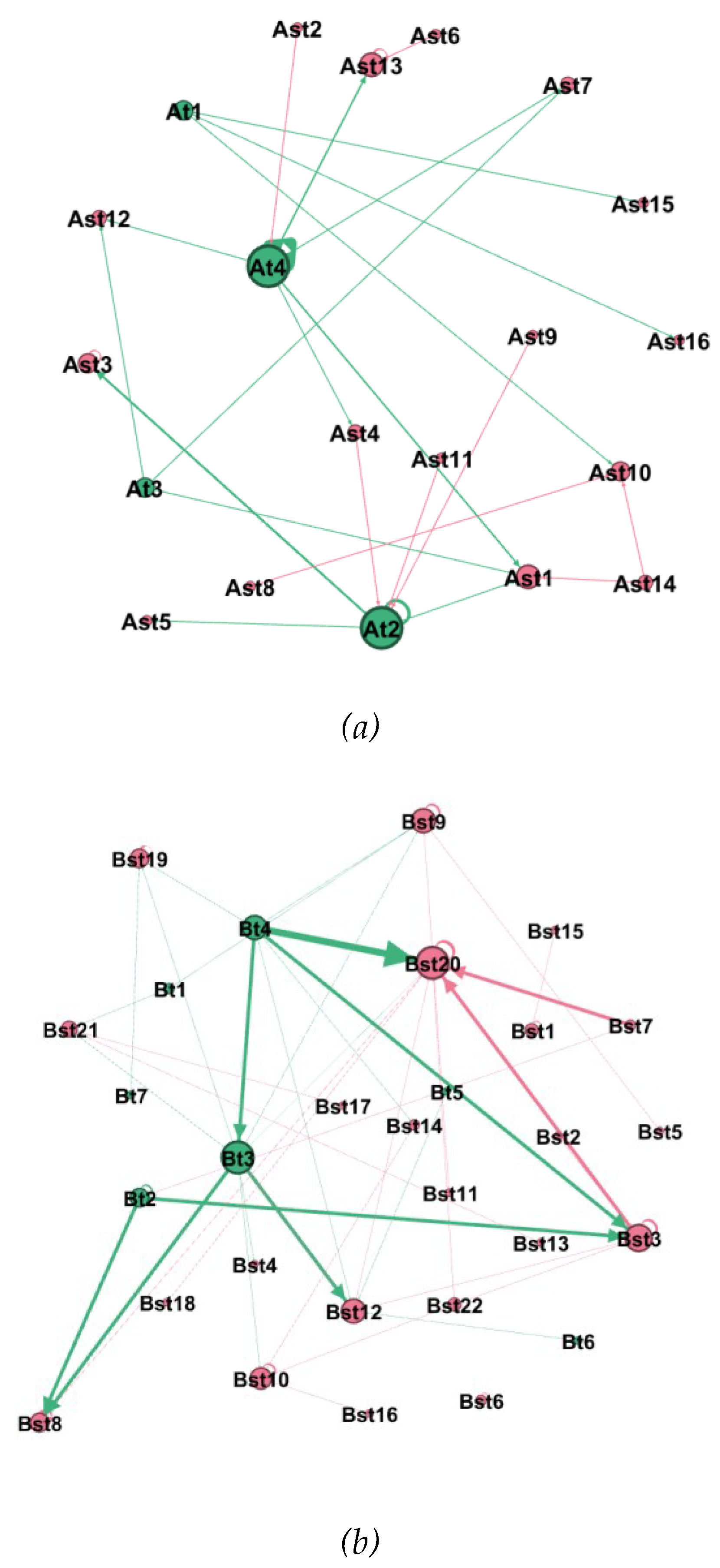
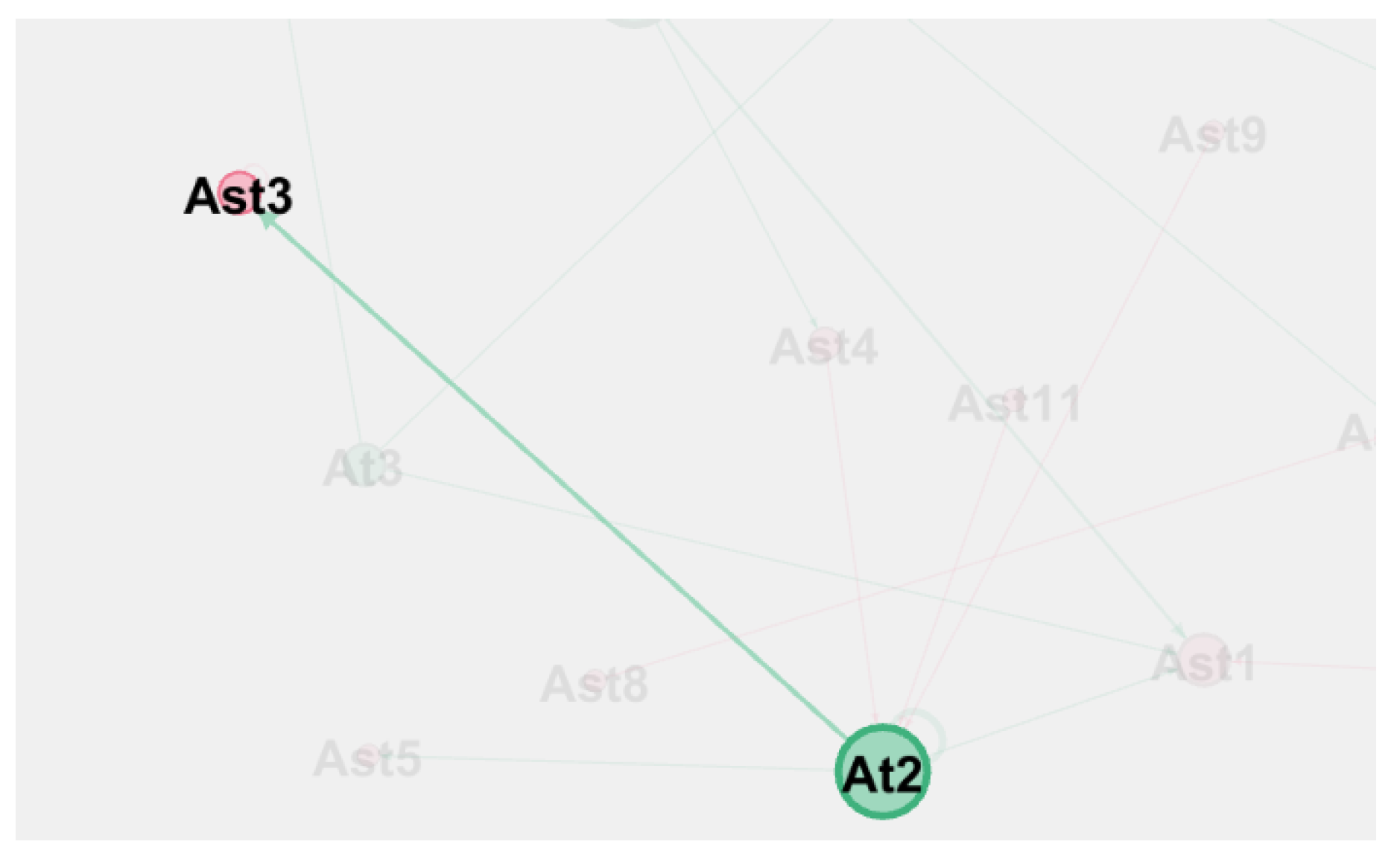
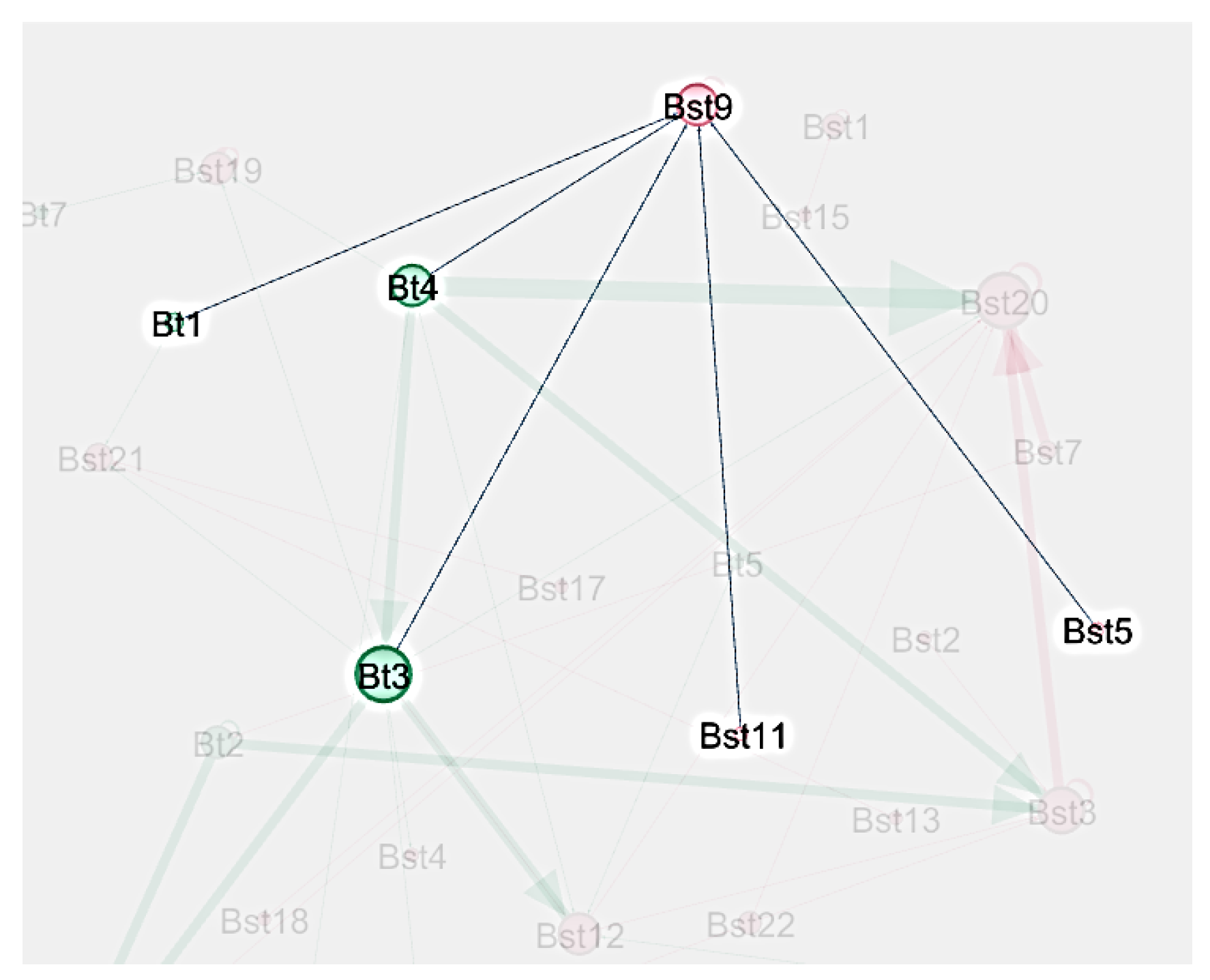
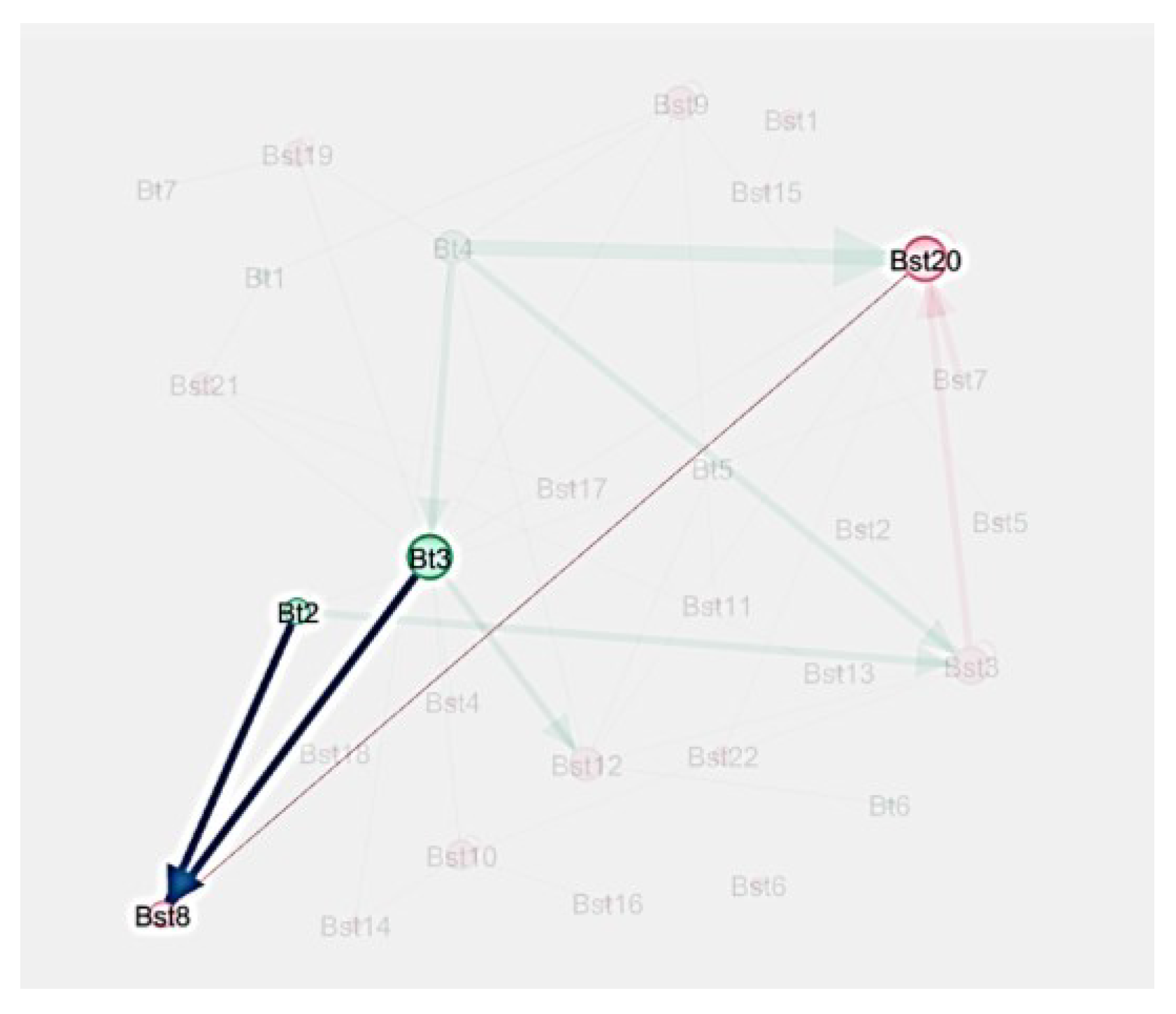
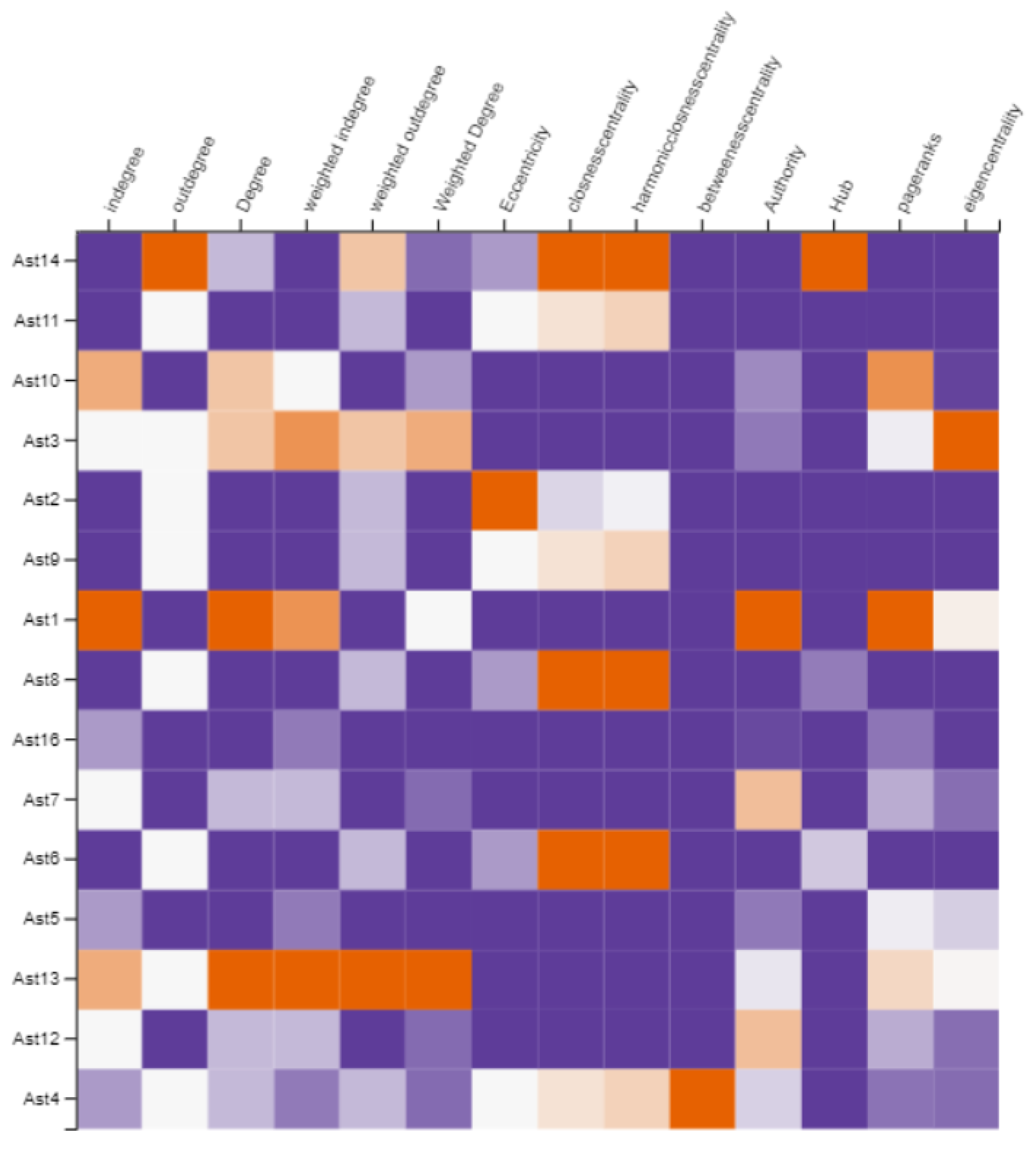
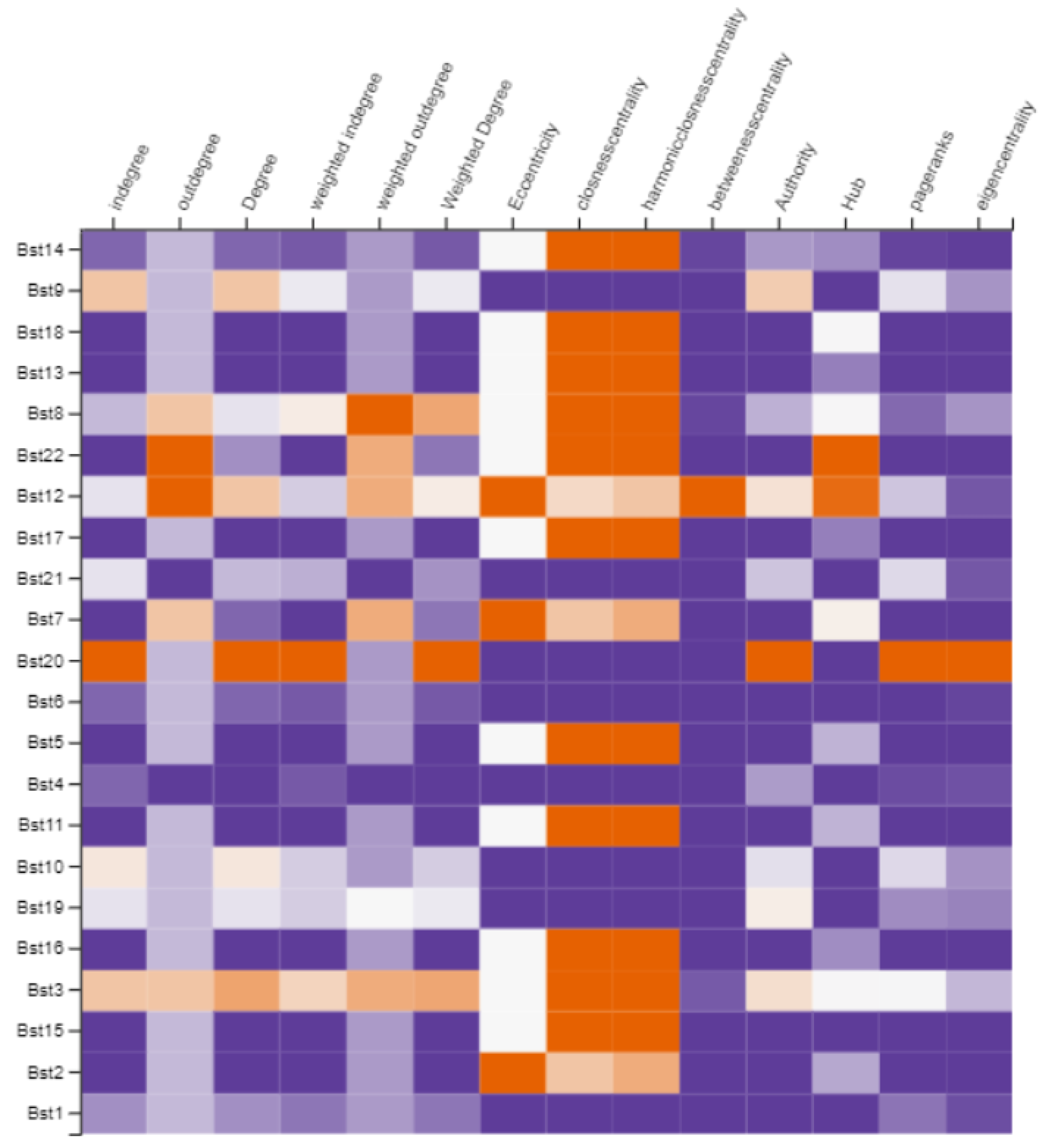
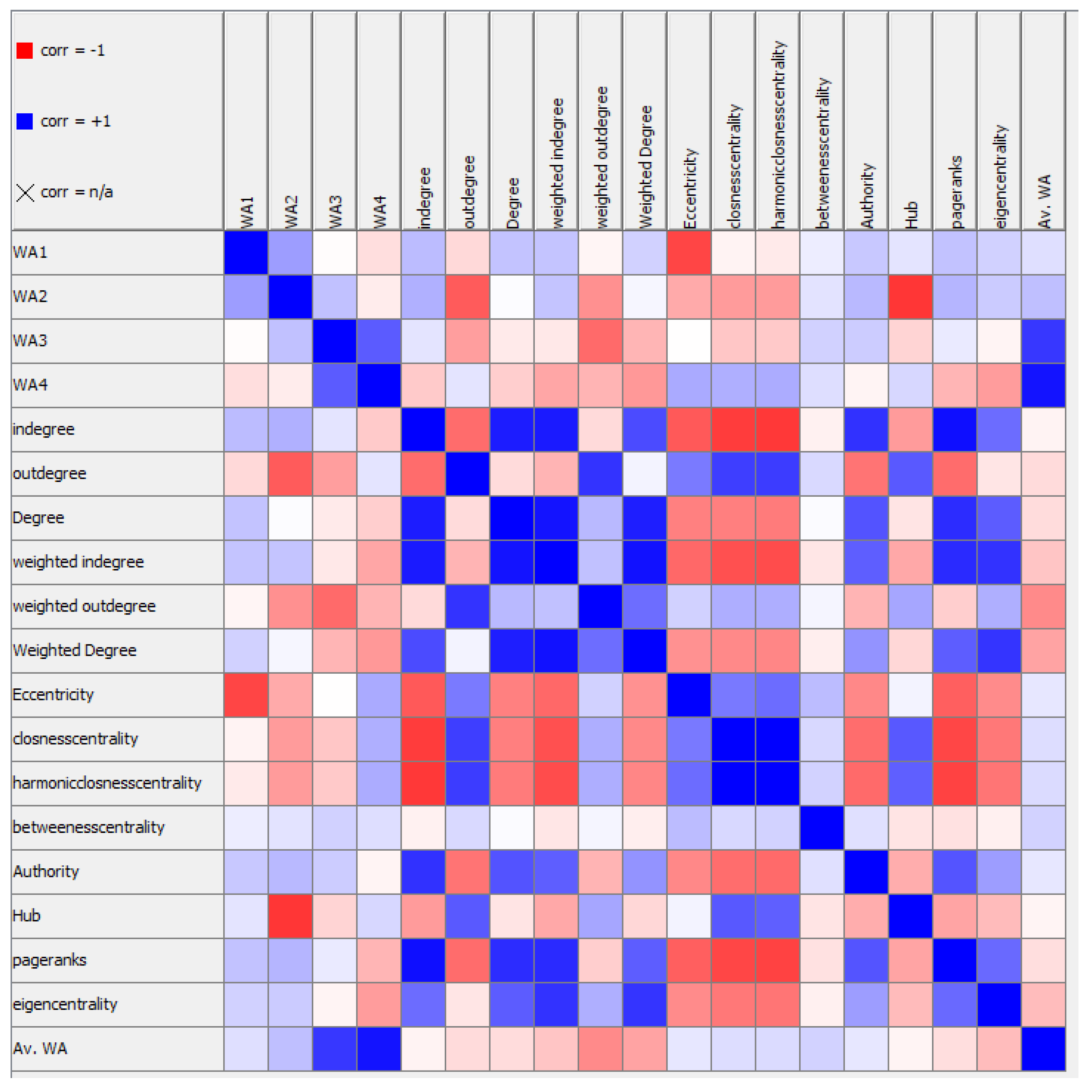
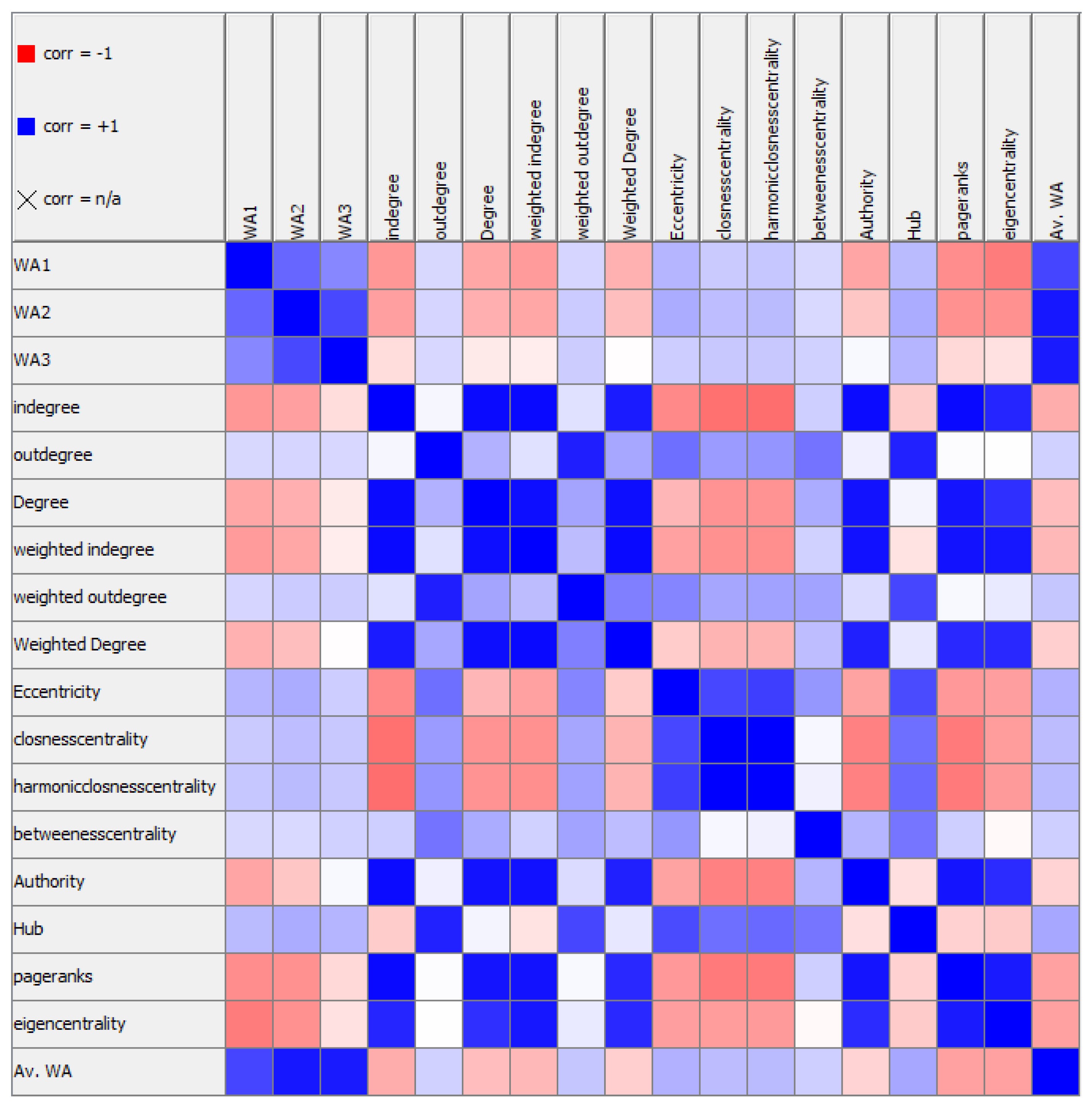
| Course A | ||||||||
|---|---|---|---|---|---|---|---|---|
| Variable | Min | Max | Mean | Std. deviation | Variance | Skewness | Kurtosis | Overall sum |
| WA1 | 7,5 | 10 | 9,83 | 0,65 | 0,42 | -3,87 | 15,00 | 147,50 |
| WA2 | 7 | 10 | 9,67 | 0,84 | 0,70 | -2,82 | 7,94 | 145,00 |
| WA3 | 7,5 | 10 | 9,47 | 0,81 | 0,66 | -1,49 | 1,40 | 142,00 |
| WA4 | 0 | 10 | 8,39 | 3,44 | 11,80 | -2,32 | 4,09 | 125,80 |
| Av. WA | 6,75 | 10 | 9,34 | 1,03 | 1,06 | -1,87 | 2,66 | 140,08 |
| In-degree | 0 | 4 | 1,27 | 1,33 | 1,78 | 0,69 | -0,64 | 19,00 |
| Out-degree | 0 | 2 | 0,67 | 0,62 | 0,38 | 0,31 | -0,40 | 10,00 |
| Degree | 1 | 4 | 1,93 | 1,10 | 1,21 | 0,89 | -0,44 | 29,00 |
| Weighted in-degree | 0 | 6 | 1,73 | 2,09 | 4,35 | 1,06 | -0,19 | 26,00 |
| Weighted out-degree | 0 | 3 | 0,87 | 0,92 | 0,84 | 0,94 | 0,52 | 13,00 |
| Weighted degree | 1 | 9 | 2,60 | 2,47 | 6,11 | 1,81 | 2,50 | 39,00 |
| Eccentricity | 0 | 4 | 0,87 | 1,19 | 1,41 | 1,47 | 2,09 | 13,00 |
| Closeness centrality | 0 | 1 | 0,34 | 0,41 | 0,17 | 0,67 | -1,22 | 5,12 |
| Harmonic closeness centrality | 0 | 1 | 0,36 | 0,42 | 0,18 | 0,54 | -1,48 | 5,36 |
| Betweenness centrality | 0 | 0,02 | 0,00 | 0,00 | 0,00 | 3,87 | 15,00 | 0,02 |
| Authority | 0 | 0,65 | 0,16 | 0,21 | 0,04 | 1,20 | 0,47 | 2,44 |
| Hub | 0 | 0,27 | 0,03 | 0,07 | 0,01 | 3,10 | 10,03 | 0,42 |
| PageRank | 0,02 | 0,06 | 0,03 | 0,01 | 0,00 | 1,01 | 0,06 | 0,46 |
| Eigenvector Centrality |
0 | 1 | 0,19 | 0,29 | 0,09 | 1,83 | 3,16 | 2,85 |
| Course B | ||||||||
|---|---|---|---|---|---|---|---|---|
| Variable | Min | Max | Mean | Std. deviation | Variance | Skewness | Kurtosis | Overall sum |
| WA1 | 5 | 10 | 8,22 | 1,63 | 2,64 | -1,09 | 0,13 | 180,90 |
| WA2 | 0 | 10 | 7,35 | 2,65 | 7,02 | -1,45 | 1,62 | 161,70 |
| WA3 | 0 | 10 | 7,50 | 3,04 | 9,24 | -1,61 | 1,69 | 165,00 |
| Av. WA | 2,9 | 9,7 | 7,69 | 2,11 | 4,47 | -1,21 | 0,52 | 169,20 |
| In-degree | 0 | 9 | 2,09 | 2,64 | 6,94 | 1,15 | 0,53 | 46,00 |
| Out-degree | 0 | 3 | 1,23 | 0,75 | 0,56 | 1,07 | 1,56 | 27,00 |
| Degree | 1 | 10 | 3,32 | 2,77 | 7,66 | 1,02 | -0,04 | 73,00 |
| Weighted in-degree | 0 | 13 | 2,64 | 3,54 | 12,53 | 1,46 | 1,95 | 58,00 |
| Weighted out-degree | 0 | 4 | 1,45 | 1,06 | 1,12 | 1,06 | 0,30 | 32,00 |
| Weighted degree | 1 | 14 | 4,09 | 3,95 | 15,61 | 1,24 | 0,54 | 90,00 |
| Eccentricity | 0 | 2 | 0,77 | 0,69 | 0,47 | 0,32 | -0,70 | 17,00 |
| Closeness Centrality |
0 | 1 | 0,59 | 0,47 | 0,22 | -0,43 | -1,83 | 12,93 |
| Harmonic Closeness Centrality |
0 | 1 | 0,60 | 0,47 | 0,22 | -0,49 | -1,81 | 13,17 |
| Betweenness Centrality |
0 | 0,03 | 0,00 | 0,01 | 0,00 | 4,64 | 21,64 | 0,03 |
| Authority | 0 | 0,57 | 0,13 | 0,17 | 0,03 | 1,11 | 0,54 | 2,83 |
| Hub | 0 | 0,29 | 0,07 | 0,09 | 0,01 | 1,26 | 1,13 | 1,64 |
| PageRank | 0,01 | 0,04 | 0,01 | 0,01 | 0,00 | 1,89 | 3,99 | 0,27 |
| Eigenvector Centrality |
0 | 1 | 0,11 | 0,22 | 0,05 | 3,30 | 12,56 | 2,50 |
| Course A | |||
|---|---|---|---|
| Variable A | Variable B | Correlation value | p value |
| WA1 | Eccentricity | -0,730 | 0,002* |
| WA2 | Out-degree | -0,644 | 0,010* |
| WA2 | Hub | -0,788 | 0,000* |
| WA3 | Weighted outdegree | -0,583 | 0,023* |
| Course B | |||
|---|---|---|---|
| Variable A | Variable B | Correlation value | p value |
| WA1 | PageRank | -0,448 | 0,037* |
| WA1 | Eigenvector centrality | -0,513 | 0,015* |
| WA2 | PageRank | -0,433 | 0,044* |
| WA2 | Eigenvector centrality | -0,432 | 0,045* |
Disclaimer/Publisher’s Note: The statements, opinions and data contained in all publications are solely those of the individual author(s) and contributor(s) and not of MDPI and/or the editor(s). MDPI and/or the editor(s) disclaim responsibility for any injury to people or property resulting from any ideas, methods, instructions or products referred to in the content. |
© 2024 by the authors. Licensee MDPI, Basel, Switzerland. This article is an open access article distributed under the terms and conditions of the Creative Commons Attribution (CC BY) license (http://creativecommons.org/licenses/by/4.0/).





